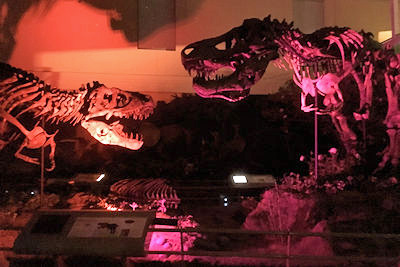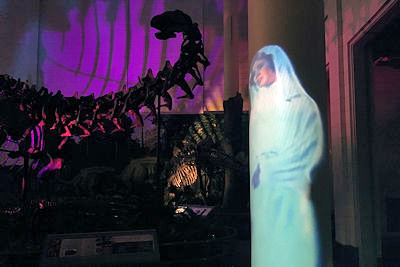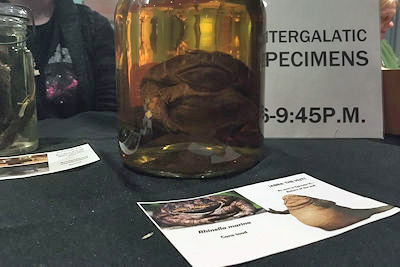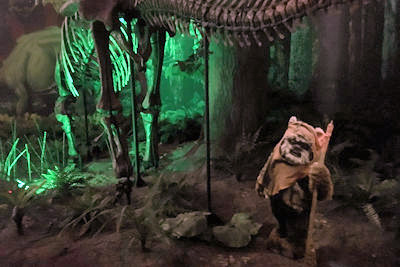
Walking into a museum can often feel like entering a strange, exotic world filled with mythical beasts and distant civilizations. Walking into a museum while the main theme from Star Wars fills the air can feel even more surreal, especially when one finds Ewoks mingling with dinosaurs, lightsaber duels in the auditorium, and Jabba the Hut preserved inside a jar.
Or so it was at the Carnegie Museum of Natural History in Pittsburgh during the evening of December 6, 2019. The Carnegie Museum regularly opens its doors to the 21+ crowd during its After Dark series, and on this particular occasion, the theme was Star Wars. Inside the Walton Hall of Ancient Egypt, local Jedi were able to explore the desert landscape of Tatooine, while the Wyckoff Hall of Arctic Life provided insight into the ice planet Hoth.
Not literally, of course, but After Dark often offers the potential of exploring the Carnegie Museum through the lens of science fiction and fantasy. Jurassic Park and Indiana Jones have been spotlighted in the past, with activities and presentations centered around each pop culture icon. The actual exhibits remain the same but can be explored from a slightly different perspective – still grounded in the real world but representative of the fictional as well.
Lightsabers are a perfect example. According to Star Wars mythology, lightsabers were powered by kyber crystals, rare gems that focus and amplify energy through the power of Force and generate a personalized color once attuned with a specific Jedi or Sith. Although kyber crystals are obviously fictional, the Hillman Hall of Minerals and Gems at the Carnegie Museum does contain examples of real world gems on par with those associated with Star Wars nonetheless.
In the late 1950s, for instance, Theodore Maiman designed a theoretical laser that pumped high levels of energy into a synthetic ruby. Although many fellow scientists believed the design would never work, Maiman received funding from the Hughes Research Laboratories in California to build it nonetheless. Then on May 16, 1960, he successfully emitted the first laser beam using the same techniques as fictional lightsabers.
After exploring physical “kyber crystals” at the Hillman Hall of Minerals and Gems, After Dark attendees could then learn about spectroscopy – a branch of science that studies the interaction between matter and electromagnetic radiation – to get an even better understanding of kyber crystals and lightsabers.
While science can be fun and enjoyable in its own right, there is still a certain thrill that comes from seeing lightsabers in action. Members of the Corsair Fencing Club were thus on hand to not only introduce the sport of fencing but also perform a “Lightsaber Spectacular Show” that featured choreographed lightsaber duels.
Another feature of the After Dark experience at the Carnegie Museum of Natural History are hands-on activities, and the Star Wars edition did not disappoint. The 21+ crowd in attendance were able to make mini glow-stick lightsabers, for instance, learn to compose secret messages in Aurebesh – the Galactic Basic written language – and even craft their own miniature glider and then test its functionality against the Millennium Falcon on the Kessel Run Glider Range.
In addition to exhibits on gems, dinosaurs, Ancient Egypt, and Canadian Inuits, the Carnegie Museum of Natural History is also home to an extensive collection of animal specimens from around the globe, including over 230,000 amphibians and reptiles preserved in fluid-filled jars. Although seldom seen by the public, a small handful – specifically those resembling creatures and species from the Star Wars Universe – were on display during After Dark.
The specimens included a bearded pygmy chameleon that – although only three inches long when fully grown – strongly resembled the dewbacks ridden by Stormtroopers on the planet Tatooine in Star Wars: A New Hope. Also on hand was a cane toad that had an eerie similarity to a much smaller Jabba the Hut, especially when seen preserved in a jar.
Then there’s the centerpiece of the Carnegie Museum, the Diplodocus carnegii affectionately known as Dippy the Dinosaurs. Discovered in 1899 and named after museum founder Andrew Carnegie, Dippy not only has a presence in Pittsburgh but numerous plaster casts of its fossilized skeleton can be found around the world, including the Natural History Museum in London, England.
That last point is significant when it comes to the world of Star Wars, as a replica of the London Dippy may have appeared in the original 1977 film. Early in the movie, droids C-3PO and R2D2 find themselves separated on the planet Tatooine. As C-3PO makes his way across a barren desert landscape, he passes the skeletal remains of a krayt dragon.
The “bones” of the krayt dragon were left in the Tunisian desert – where the scene was filmed – after production, and were later discovered by numerous filmmakers and archeologists. In a blog post on the Carnegie Museum of Natural History website, resident paleontologist Matt Lamanna mentions that he once examined a close-up photo of the krayt dragon’s “remains” and realized that there was a strong resemblance to not only those of sauropod dinosaurs in general but the Diplodocus carnegii in particular.
Additional online research confirmed that others had reached the same conclusion. Furthermore, speculation exists that the replica skeleton used by George Lucas when filming the krayt dragon scene in Star Wars was the same one that appeared in a 1975 Disney film entitled One of Our Dinosaurs Is Missing – a comedy set in the 1920s about a spy who hides microfilm in the skeleton of a dinosaur on display at the Natural History Museum in London, which is then stolen in order to recover the microfilm.
Although not named in the film, the dinosaur in question was the duplicate Dippy that Andrew Carnegie gifted to the museum. The replica created for One of Our Dinosaurs Is Missing was thus based on Dippy, and if that replica was then later used in Star Wars, the krayt dragon skeleton lying in the desert of Tatooine is none other than Dippy the Dinosaur.
Fun facts and activities based on science fiction and fantasy, coupled with the real world science depicted in traditional museum exhibits, are all part of what makes the After Dark series at the Carnegie Museum of Natural History both an enjoyable and educational experience. Where else, after all, can one learn about the similarities between Earth and the planets Tatooine and Hoth, discover the science of lightsabers, see an actual krayt dragon, and find Jabba the Hut preserved in a jar?
Anthony Letizia





